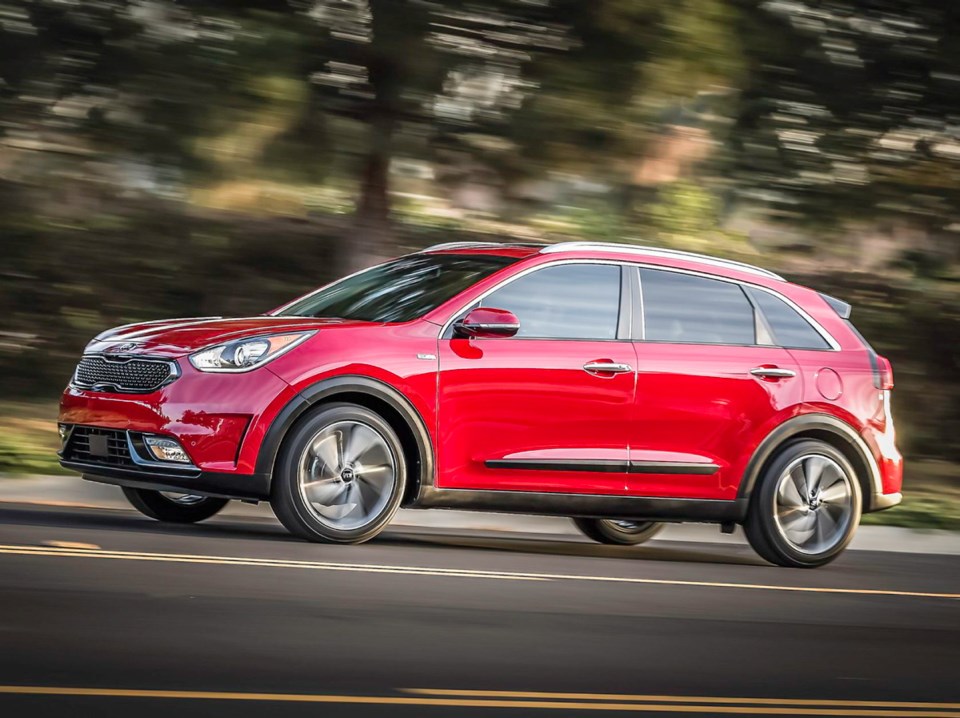The electric-vehicle era is now well and truly upon us and will doubtless expand over the next few years.
One of the foremost class members is the Kia Niro, which tries to be all things to all eco-minded buyers. Along with a battery-electric model, there’s a gasoline-electric hybrid variant as well as a plug-in hybrid version (PHEV) that uses the same powertrain.
The Niro trio arrives at a time of relatively stable fuel prices. They’ll need to rely on practicality and price, as well as economy of operation, to make a dent in the marketplace. Note that Hyundai — Kia’s parent — has the similarly powered Ioniq hatchback models, plus the electric version of the Kona small wagon.
The Kia Niro wagon’s compact shape has the practical part of the equation well in hand. The cargo area offers plenty of space with the rear seat in place or folded flat. You would never guess that the hybrid’s compact lithium-ion battery pack is hidden beneath the back seat.
The cabin is also a paragon of normalcy, other than a specific gauge for monitoring the hybrid or electric system’s operations, including the recovery system that feeds braking energy to the battery pack.
At the heart of both Niro hybrid models is a 1.6-litre four-cylinder engine that by itself makes 104 horsepower and 109 pound-feet of torque. It’s paired with a 43-horsepower electric motor that produces 125 pound-feet of torque. Together, they’re rated at 139 horsepower and 195 pound-feet of torque.
Directing thrust to the front wheels is a six-speed automatic transmission with a manual-shift mode. That’s different than most other hybrids, including the Toyota Prius, which use continuously variable transmissions with no set gear ratios.
In standard “eco” mode, the hybrid’s six-speed maximizes the electric-only operating range and extracts the lowest fuel-consumption rating of 4.5 l/100 km in the city, 4.8 on the highway and 4.6 combined. Placing the shifter in Sportmatic mode increases gasoline-engine use for better acceleration, but will negatively affect fuel economy. Sportmatic mode also adds steering feel, according to Kia.
Opt for the PHEV and you’ll get an officially rated 42 kilometres of electric-only range before the gasoline engine takes over.
Meanwhile, the new-for-2019 Niro EV should be easy to spot. A dimpled nose trimmed in electric blue replaces the traditional grille, and a small portal on the driver’s side hides both the 240-volt charge port and the 480-volt direct-current (DC) fast-charge receptacle.
At 240 volts, the battery pack charges in about 9.5 hours. At 480 volts DC, the Niro gets to 80 per cent of capacity in a claimed 75 minutes (a 30-minute charge will yield 160 kilometres of range). Note that the DC chargers are commercial-grade and you’ll have to locate them on your route, or plan your route around them.
The EV’s 201-horsepower motor — with 291 pound-feet of torque — links to a single-speed controller. In ideal (warm) weather, the maximum range is pegged at 382 kilometres by Kia.
Niro hybrid pricing starts at $27,400, including destination charges, for the base L trim. It gets dual-zone air conditioning and a seven-inch touchscreen.
The EX Premium adds roof rails, an under-floor storage tray and LED headlights, while the EX comes with upgraded interior trim, heated front seats plus a number of active-safety technologies, including emergency braking.
The SX Touring tops up with leather seat covers, power adjustable driver’s chair, Harmon Kardon-brand premium audio package, and front and rear park-assist warning systems. The standard 16-inch steel wheels are upgraded to 18-inch alloys for the Touring.
The least-expensive PHEV trim starts at $35,850, but it comes with more equipment than the base hybrid and is eliglble for a $2,500 Canadian-government rebate (up to $4,000 more for the PHEV in Quebec as well as in B.C.).
Niro EV pricing comes in at $46,900 to start, but the vehicle is eligible for a $5,000 federal rebate and up to $8,000 more in B.C. and Quebec.
No matter which system you choose, the Kia Niro stands ready to significantly reduce, or entirely eliminate, your trips to the pump.



